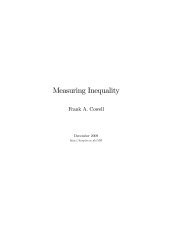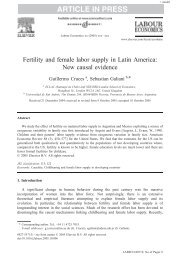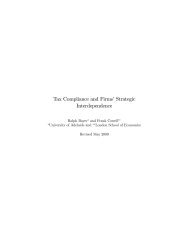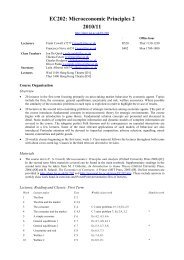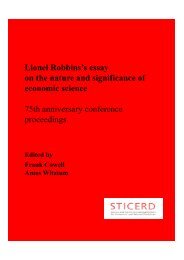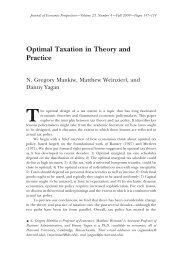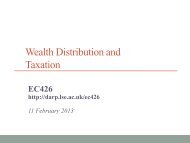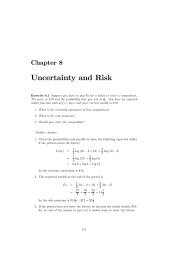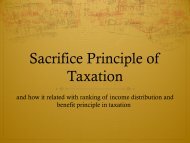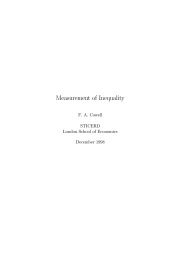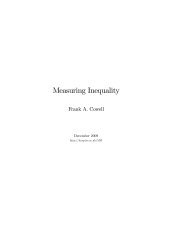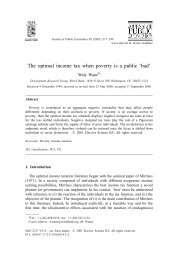author's proof - DARP
author's proof - DARP
author's proof - DARP
You also want an ePaper? Increase the reach of your titles
YUMPU automatically turns print PDFs into web optimized ePapers that Google loves.
AUTHOR'S PROOF<br />
Reference distributions and inequality measurement<br />
JrnlID 10888_ArtID 9238_Proof# 1 - 08/01/13<br />
Q2<br />
sensitive inequality where, in terms of “distance from maximum inequality,” the 253<br />
change in the distribution is inconclusive. 254<br />
Theoretical distribution Finally let us consider how inequality changed using a con- 255 Q4<br />
tinuous reference distribution F ∗ . The last panel of Table 2 tabulates the results for 256<br />
three F ∗ from the Beta distribution family. Did UK income inequality, interpreted 257<br />
as a distance from a Beta-family reference distribution increase We can see that 258<br />
the values of J α are not statistically different between 1979 and 1988 when the 259<br />
Beta(1,1) (uniform) or Beta(2,5) (unimodal, right skewed) is used as the reference 260<br />
distribution distribution, while they are statistically different when the Beta(2, 2) 261<br />
(unimodal symmetric) is used as the reference distribution. 262<br />
The estimates of the standard GE inequality measures J α,1,1 and of those of J α,k,p 263<br />
and J α in Table 2 provide us with different information about divergence of the 264<br />
empirical distribution from the chosen reference distribution. By varying the values 265<br />
of k and p, one can specify the exact skewness of the reference distribution one would 266<br />
like to measure distance of the empirical distribution from. Likewise, by varying the 267<br />
values of α one can focus on different parts of the income distribution. A large value 268<br />
of α implies a greater weight on parts of the distribution where the observed incomes 269<br />
are vastly different from the corresponding values in the reference distribution. 270<br />
Finally, one can choose specific parametric distributions which correspond to the 271<br />
relevant reference distribution that the researcher is interested in. 272<br />
5 Conclusion 273<br />
The problem of comparing pairs of distributions is a widespread one in distributional 274<br />
analysis. It is often treated on an ad-hoc basis by invoking the concept of norm 275<br />
incomes and an arbitrary inequality index. 276<br />
Our approach to the issue is a natural generalisation of the concept of inequal- 277<br />
ity indices where the implicit reference distribution is the trivial perfect-equality 278<br />
distribution. Its intuitive appeal is supported by the type of axiomatisation that 279<br />
is common in modern approaches to inequality measurement and other welfare 280<br />
criteria. The axiomatisation yields indices that can be interpreted as measures of 281<br />
divergence and are related to the concept of divergence entropy in information 282<br />
theory [10]. Furthermore, they offer a degree of control to the researcher in that 283<br />
the J α indices form a class of measures that can be calibrated to suit the nature of the 284<br />
economic problem under consideration. Members of the class have a distributional 285<br />
interpretation that is close to members of the well-known generalised-entropy class 286<br />
of inequality indices. 287<br />
In effect the user of the J α -index is presented with two key questions: 288<br />
UNCORRECTED PROOF<br />
1. the income discrepancies underlying inequality are with reference to what 289<br />
2. to what kind of discrepancies do you want the measure to be particularly 290<br />
sensitive 291<br />
As our empirical illustration has shown, different responses to these two key ques- 292<br />
tions provide different interpretations from the same set of facts. 293



